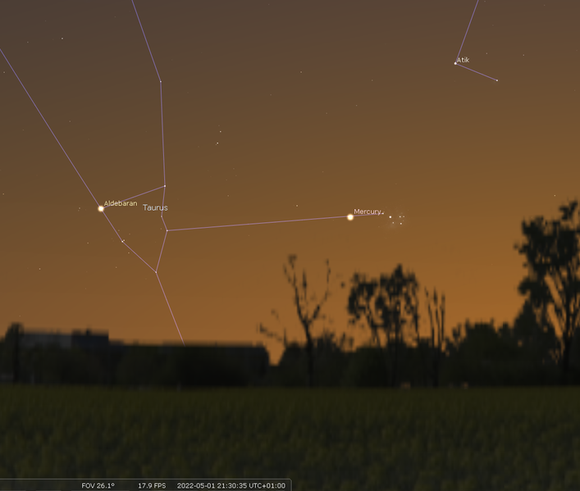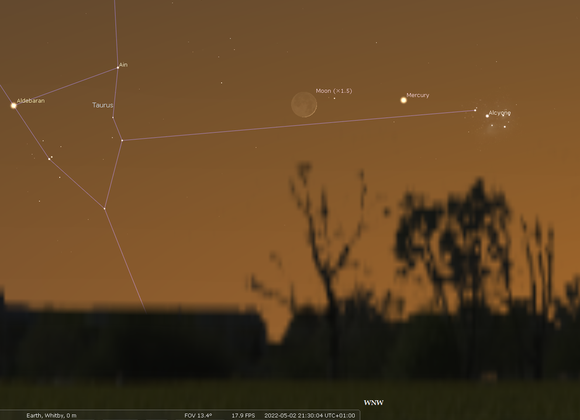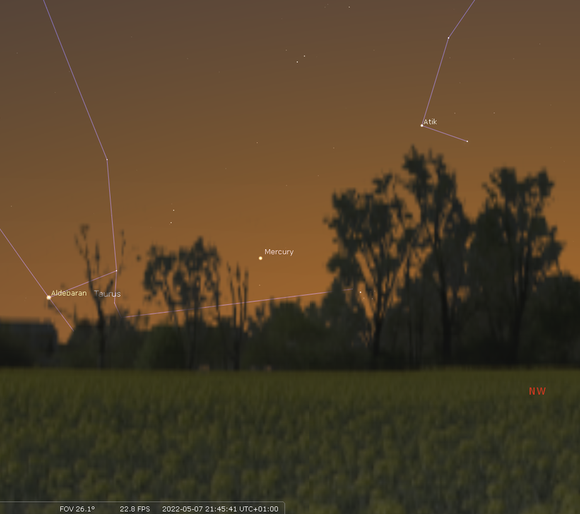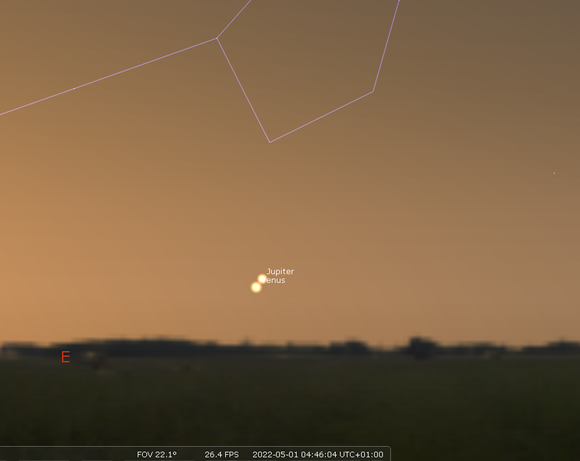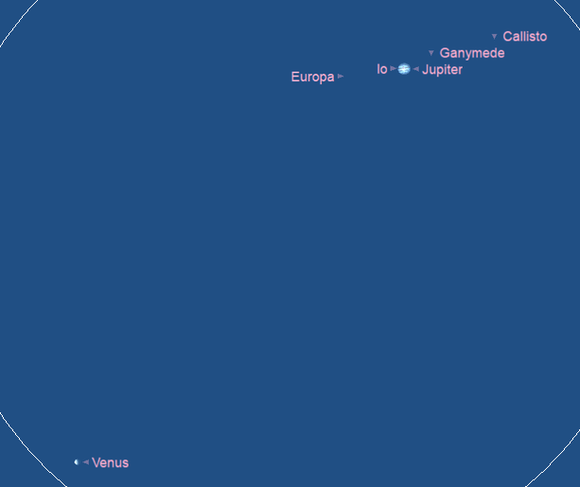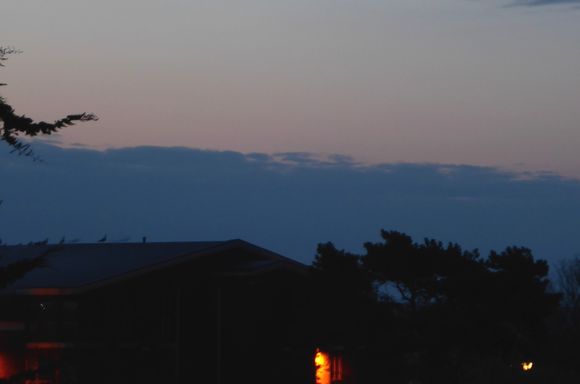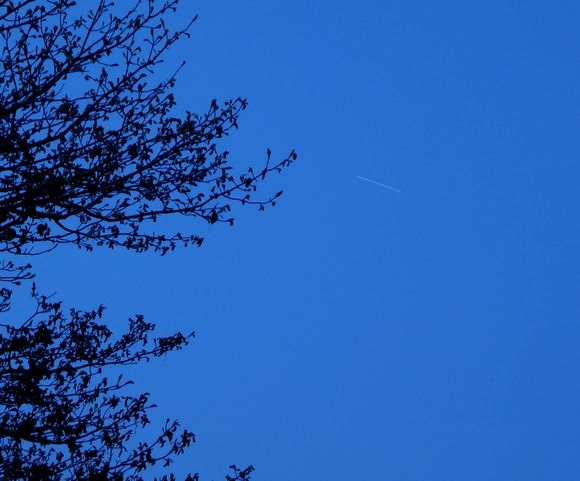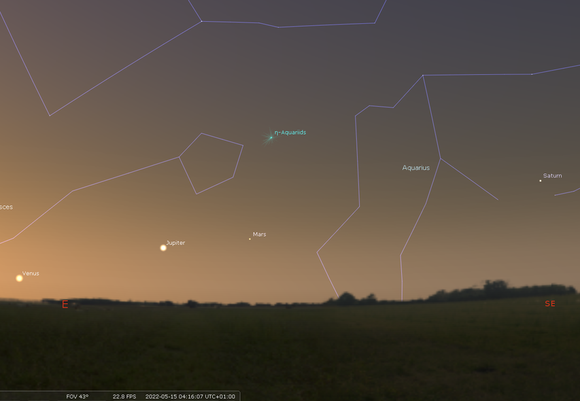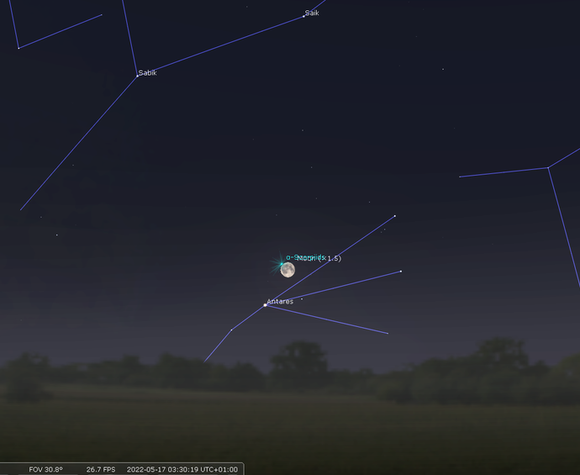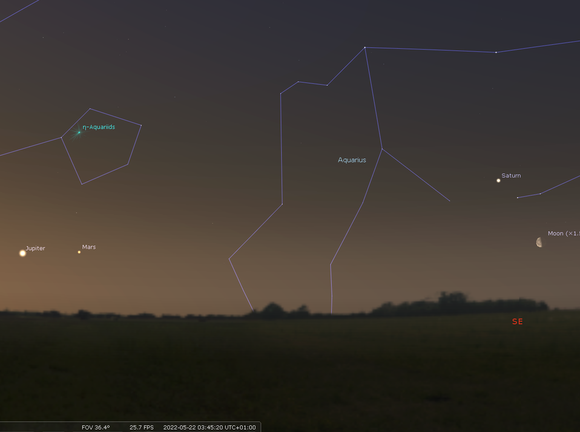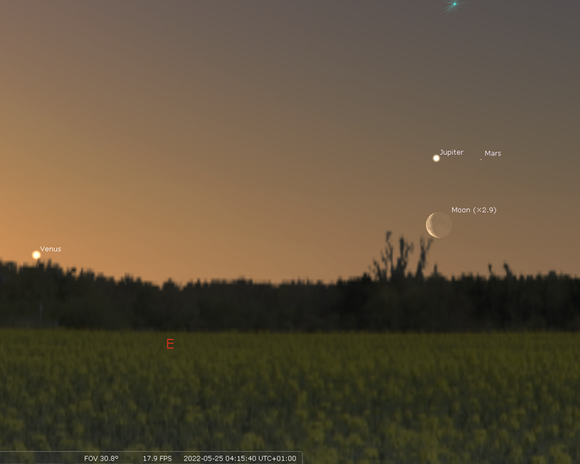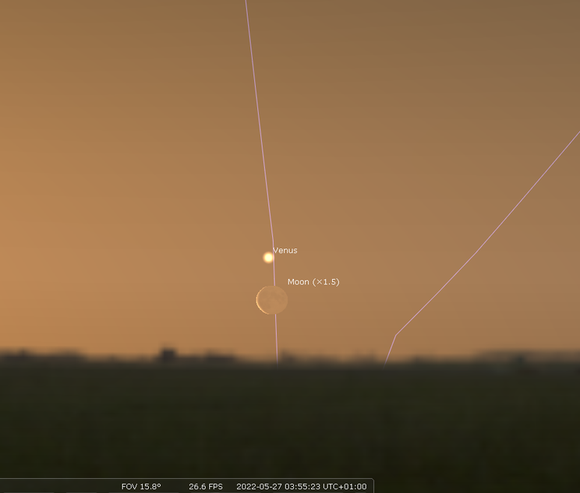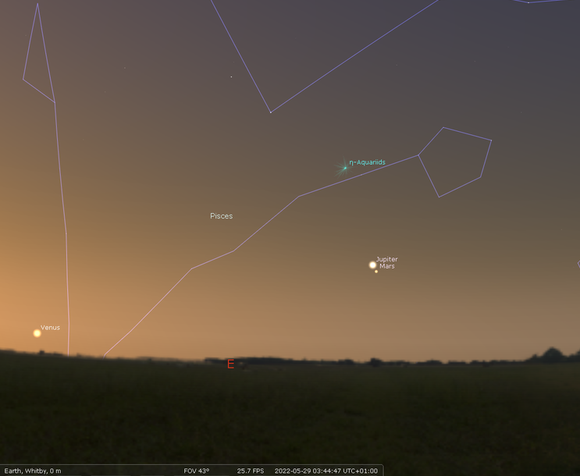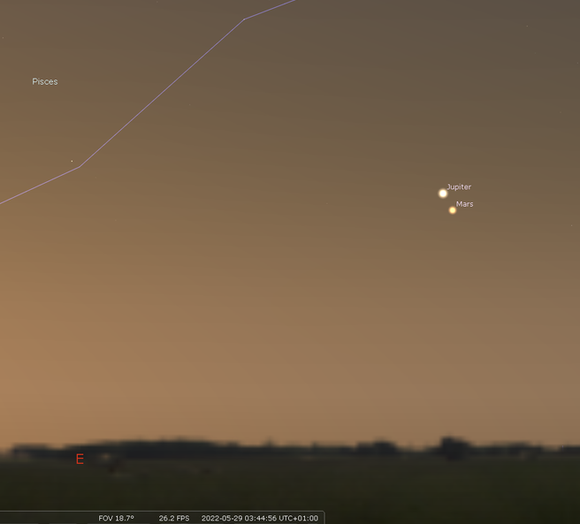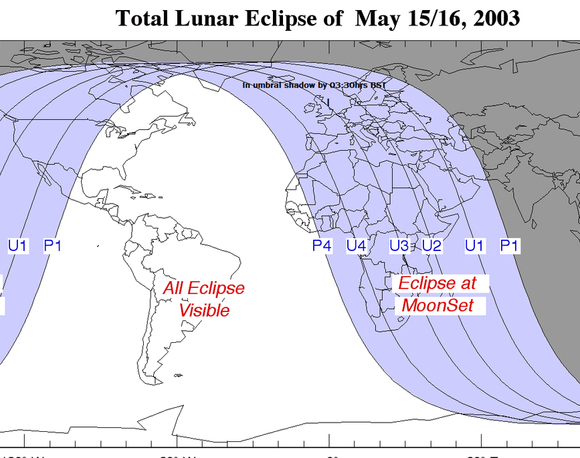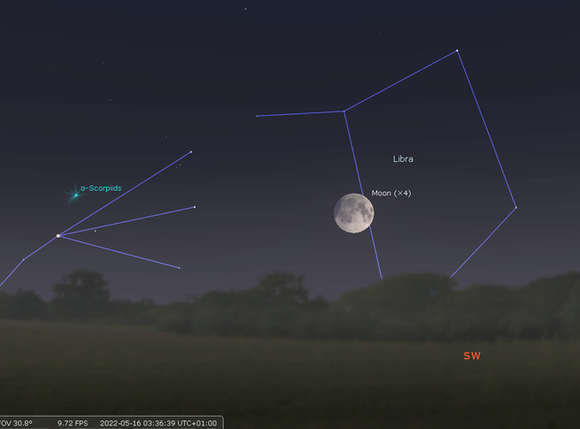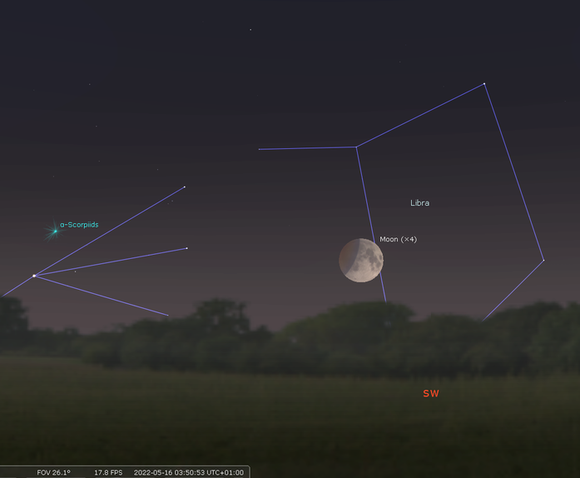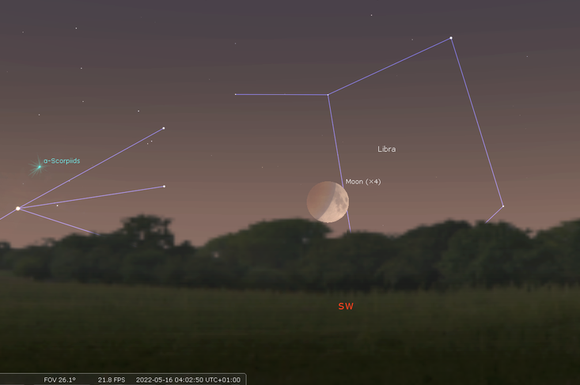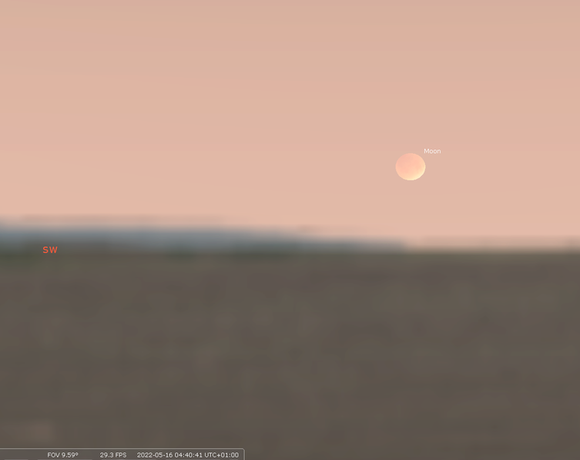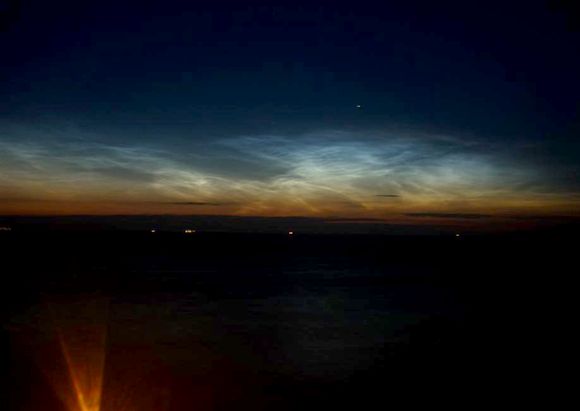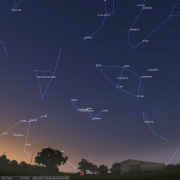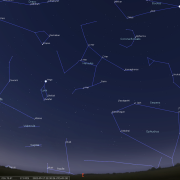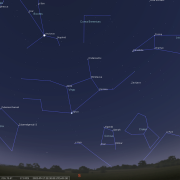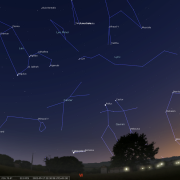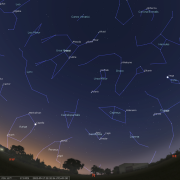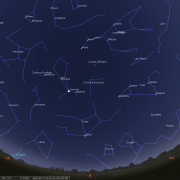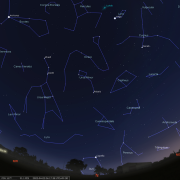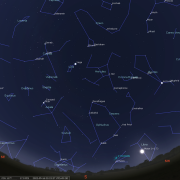In this month's Sky Notes:
- Planetary Skylights
- Lunar Eclipse - set for dawn sky
- Meteors -Eta Aquarids
- Noctilucent cloud season begins
- May Night Sky
- May 2022 Sky Charts
Planetary Skylights - Brief
Evening highlight: Mercury twilight finale, encounter with the seven sisters and a new moon. Dawn highlight: Venus and Jupiter's spectacular close shave. Mars and Saturn also visible in pre-dawn twilght. Jupiter and Mars meet at the month's end.
 Mercury concludes its most favourable evening apparition with a fitting finale to grace the May twilight sky. Look for this elusive world at the start of the month very low in the WNW around 35-45 minutes after sunset. An observing site with unobstructed views of the horizon will enable the best chance of tracking Mercury down. At magnitude +0.7 Mercury will appear reasonably conspicuous, but somewhat fainter than at the start of this apparition in mid-April. Located around 8 degrees above the WNW horizon 45 minutes after sunset, Mercury should be visible in transparent skies to the naked eye, but binoculars will assist greatly in spotting. On May 1st, Mercury sits to the left of the lovely Pleiades star cluster - the Seven Sisters, making for a fine sight in a pair of binoculars. It gets even better the following evening (May 2nd), when a very slender crescent moon just a few days old resides to the left of Mercury. The orange star to the left of the Moon and Mercury is Aldebaran. Over the coming evenings watch as both Mercury and the Pleiades slide down toward the horizon, effectively becoming lost in solar glare by May 10th.
Mercury concludes its most favourable evening apparition with a fitting finale to grace the May twilight sky. Look for this elusive world at the start of the month very low in the WNW around 35-45 minutes after sunset. An observing site with unobstructed views of the horizon will enable the best chance of tracking Mercury down. At magnitude +0.7 Mercury will appear reasonably conspicuous, but somewhat fainter than at the start of this apparition in mid-April. Located around 8 degrees above the WNW horizon 45 minutes after sunset, Mercury should be visible in transparent skies to the naked eye, but binoculars will assist greatly in spotting. On May 1st, Mercury sits to the left of the lovely Pleiades star cluster - the Seven Sisters, making for a fine sight in a pair of binoculars. It gets even better the following evening (May 2nd), when a very slender crescent moon just a few days old resides to the left of Mercury. The orange star to the left of the Moon and Mercury is Aldebaran. Over the coming evenings watch as both Mercury and the Pleiades slide down toward the horizon, effectively becoming lost in solar glare by May 10th.
Through a telescope Mercury is little to look at, a small phase may be discerned resembling a first quarter moon, but observations are usually hampered by unstable air present at low levels. Snap shots against a scenic background are perhaps most pleasing and given the location of the Moon and Pleiades in relation to Mercury this offers up a fantastic opportunity to capture some.
Dawn Planets

 The pre-dawn sky is home to the remainder of the naked eye planets, arranged as they are low above the east-southeast horizon and thus requiring a clear eastern aspect. With dawn arriving ever earlier, possible observations are curtailed by growing light shortly after 05:00hrs at the start of May and a little after 04:00hrs by the month's end. The very first morning of May started in spectacular fashion with the two brightest planets in the sky coming together in close conjunction with brilliant Venus 'morning star', being joined by the conspicuous presence of Jupiter.
The pre-dawn sky is home to the remainder of the naked eye planets, arranged as they are low above the east-southeast horizon and thus requiring a clear eastern aspect. With dawn arriving ever earlier, possible observations are curtailed by growing light shortly after 05:00hrs at the start of May and a little after 04:00hrs by the month's end. The very first morning of May started in spectacular fashion with the two brightest planets in the sky coming together in close conjunction with brilliant Venus 'morning star', being joined by the conspicuous presence of Jupiter.
A separation between them of just a third of a degree increases only slightly the following morning (May 2nd) as Jupiter passes above Venus. Both planets should be close enough to fit in the same field of view of a short focal length telescope at low magnification (<40x) Binoculars will afford pleasing general views, whilst the image thru' the eyepiece of a telescope will appear rather turbulent. Following this conjunction, note how both planets then head in opposite directions with Jupiter involved in yet another planetary conjunction later in the month, this time with Mars. Even in the bright conditions Venus; at magnitude -4.2 is conspicuous to the eye . Jupiter, at mag -2 is no shrinking violet either! As mentioned, telescopic views will not be marvellous, but you should discern the phase of Venus and perhaps the major banding across Jupiter with Galilean moon's in close attendance. Don't expect to see finer details though.
Mark did attempt to view the two planets on the final day of April. He popped down the road at 04:35hrs to take a few images of the pair. It was a lovely clear morning ....almost everywhere, except where Venus and Jupiter should have been. This location in the sky had obviously been reserved for a cloud bank and despite lot's of pacing 'to and fro', the planets remained hidden!!**! Mark did however capture the ISS going over, so his efforts weren't entirely wasted.

 Venus and Jupiter aren’t alone in the dawn sky, with Saturn and Mars also present. Saturn sits low in the southeast; masquerading as a prominent star of magnitude + 0.8 and by mid month has climbed to around 15 degrees above the horizon viewing at 04:00hrs. In a telescope the rings of Saturn will be apparent, however the image will be somewhat compromised from the UK by poorer seeing conditions found at lower elevations, that said the air is usually more stable on a morning than in the evening. Over the course of May, Saturn is distanced further by Mars which resides further round to the east and is noticeably more orange in hue.
Venus and Jupiter aren’t alone in the dawn sky, with Saturn and Mars also present. Saturn sits low in the southeast; masquerading as a prominent star of magnitude + 0.8 and by mid month has climbed to around 15 degrees above the horizon viewing at 04:00hrs. In a telescope the rings of Saturn will be apparent, however the image will be somewhat compromised from the UK by poorer seeing conditions found at lower elevations, that said the air is usually more stable on a morning than in the evening. Over the course of May, Saturn is distanced further by Mars which resides further round to the east and is noticeably more orange in hue.
 By mid-month a waning moon gate crashes the party, but first pays Antares - chief star in Scorpius, a visit on May 17th when just past full. The morning before The Moon will be in eclipse ( see Lunar Eclipse at Dawn - further down). Look for Antares and the Moon in the pre-dawn sky during the early morning hours.
By mid-month a waning moon gate crashes the party, but first pays Antares - chief star in Scorpius, a visit on May 17th when just past full. The morning before The Moon will be in eclipse ( see Lunar Eclipse at Dawn - further down). Look for Antares and the Moon in the pre-dawn sky during the early morning hours.
By May 22nd the moon has moved around to the SE and will lie below Saturn, before passing below Mars and Jupiter on May 25th.
By the time The Moon reaches Mars and Jupiter, both have climbed in elevation a tad, the Red planet having been joined by Jupiter in the final week of May. The Moon will be 'in line' and below Jupiter on May 25th, with Mars; which will be a third the brightness of Jupiter, just off to its right.
The Moon then moves on for a final close encounter, joining Venus on May 27th in a lunar-planetary conjunction. Venus will lie immediately above the slender moon. View at 03:55hrs.
Finally, the Jupiter-Mars conjunction occurs over three mornings from May 28th to the 30th, the two worlds separated by less than half a degree in the sky on the 29th. upiter may just stand telescopic observations; Mars will be small, orange and featureless. The view may be best appreciated through binoculars.
Lunar Eclipse Set for Dawn Sky
There is a total lunar eclipse on May 16th visible from parts of the US, all of South America, the Atlantic and western coasts of NW Africa. Here in the UK we just miss out - so near, yet so far - with The Moon setting from round these parts as totality is reached. If skies are forecast to be clear on the morning of May 16th set the alarm for 03:30hrs BST.
The Full Moon will already be low in the SW sky and already in penumbral shadow - the lightest type of shadow. The Moon enters in Earth's umbral shadow shortly after 03:30hrs BST when this deeper shadow starts to creep across the lunar surface from top left. By 04:00hrs the umbral shadow has reached roughly half way across the lunar surface, however by then The Moon will sit just above the SW horizon.
16-May-2022 at 04:40h BST: The Moon in totality as it nears the horizon less than one degree
(Click for full-sized image)
You will require a unobstructed view to right down to the horizon to stand any chance observing the Moon enter totality. This will at 04:30hrs BST and is virtually as the Moon is starting to set, which it does so at 04:50hrs BST. Light will also play a role as too what will be observed, it will actually be almost sunrise so it should be an interesting watch. Cameras at the ready, but be fearful of cloud banks!!
Meteor Watch - Eta Aquarids

If you are a ‘very early riser’ (around 03:00hrs), you may spot some shooting stars belonging to the Eta Aquarid meteor shower in the predawn sky of the 6th – the peak date of the shower. With Aquarius only just rising in the early morning hours at this time of year, the shower radiant will not be high for northern hemisphere observers, otherwise observed rates would be more prolific than they are - so perhaps a dozen instead of the ZHR of 25 -30. The Eta Aquarids is one of two meteor showers associated with debris particles deposited over time by comet Halley, the other shower being the Orionids, seen in late October. View to the east, south, and high to the southeast.
Noctilucent Cloud Season
Towards the end of May keep watch for sightings of Noctilucent cloud. This rather beautiful type of cloud formation only forms during the early summer months and may only be seen above the northern horizon long after sunset, often around midnight. Its appearance is quite distinct, filamentary in structure, shining quite brightly and exhibiting a characteristic silvery-blue hue. It forms exclusively between latitudes 50 and 60 degrees north, at an altitude of over 50 miles, five times higher than normal clouds. The cloud forms when water vapour condenses at the low temperatures that prevail at such altitudes onto particles suspended in the air.
May Night Sky - in Brief
Constellation recognition becomes increasingly tricky as we head deeper into May, late evenings become ever lighter and the hours of darkness become hours of 'semi-darkness' as first, astronomical twilight is not attained and then nautical twilight levels are barely reached (see In-Focus - Twilight and Shadow).
By using the brightest stars visible you can still navigate around the sky. Some star patterns are always recognisable, the Plough or Big Dipper asterism for instance is now directly overhead; its outline familiar to many. This famous asterism forms the hindquarters of Ursa Major the Great Bear. Follow the sweep of the stars in the handle and ‘arc to Arcturus’, the brilliant amber star in Bootes located high in the SE, then speed on to Spica in Virgo down in the South. Spica stands to the left of Corvus and Crater, less prominent constellations riding on the coils of Hydra which sprawls across the lower regions of the SE, south and SSW. In this direction the water snakes lead star; Alphard - the Lonely One resides.
It will be post 23:00hrs before skies are dark enough to trace all of Hydra and associates. Higher in SW Leo is pretty conspicuous, highlighted by Regulus in the ‘Sickle’ asterism. Behind Leo and above Virgo sits Coma; often overlooked but full of interest. Three stars associated with the winter sky; Procyon, Castor and Pollux are all about to depart in the west.
Another ‘winter’ star, Capella in the constellation of Auriga, located in the NW will however remain, skirting above the N horizon during summer. Rising in the NE, the sparkling steely blue hue of Vega in Lyra is particularly eye catching, whilst lower still Deneb in Cygnus follows Vega up.
The third and non-circumpolar member of the summer triangle, Altair in Aquila, becomes visible low to the east by mid month. Look for orange Antares in Scorpius low to the SSE late in May shortly after 23:30hrs. Serious stargazing may be difficult and inconvenient, but if the sky is clear and conditions mild, it is a joy just to go out and admire the ever-changing aspect of the night sky.
May 2022 Sky Charts
All times BST - British Summer Time
Additional Image Credits:
- Planets and Comets where not otherwise mentioned: NASA
- Sky Charts: Stellarium Software and Starry Night Pro Plus 8
- Log in to post comments

